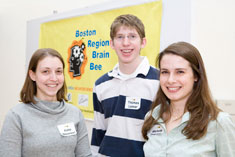
Michelle Tangredi, right, with fellow neuroscience student Katie Malanson and Thomas Lamar, who represented Lexington High School in this year's Brain Bee competition. Photo: Alonso Nichols
The Brain Bee
Graduate student Michelle Tangredi is a driving force behind a neuroscience knowledge competition for Boston-area high schoolers
By Bruce Morgan
OK, class, clear your desks and take out a fresh pencil. The quiz is about to begin.
First, what is the name of the material that insulates the axons of some neurons? What hollow embryonic structure forms the brain and spinal cord? In which part of the brain does the auditory nerve terminate? Those who did not get myelin, neural tube and medulla (or brain stem), in that order, please stop by after class for further review.
If you're a high school kid with a taste for neuroscience, you likely already know about the Boston Regional Brain Bee competition, held this year at MIT and sponsored by the Boston Area Neuroscience Group (BANG), which includes member institutions Brandeis, Boston University, Harvard, MIT, Northeastern, Tufts and UMass-Medical School and is the local chapter of the National Society for Neuroscience. The idea is to instill the excitement for the field into budding teen scientists around the Hub. Michelle Tangredi, a doctoral student in neuroscience at Tufts, has been the driving force behind the event since its inception three years ago.
About 40 kids from 18 high schools showed up in early February to field increasingly difficult questions drawn from the 64-page "Brain Facts" book, presented first on paper, and, for the 10 finalists who survive, live before the judges. The day's program also included a career panel luncheon, with a sampling of people who have chosen a variety of options for their life work, and a keynote address from a celebrated neuroscientist.
This year's first-place winner, Anna Nathanson from Newton South High School, took home $350 and the chance to compete against other regional winners in the National Brain Bee in mid-March. Newton South, which offers a rare-as-hen's-teeth high school neuroscience course, has taken first place all three years of the Boston contest. "They kind of have a little legacy going on," says Tangredi with a smile.
Tangredi is really the brains behind the Bee, the pilot light that keeps it going. She pours herself into building participation for the event, distributing early notices to some 280 high schools and colleges and universities in the region. She sends out bulk e-mails to Boston-area science teachers and principals. If the Museum of Science happens to hold a conference for high school teachers, a gathering of likely prospects, "I go there," Tangredi states matter-of-factly.
Raised in Milford, Mass., the daughter and granddaughter of teachers, Tangredi harbors something like a genetic itch to spread the word. "I enjoy teaching-taking what I've learned and trying to share it with someone else," she explains.
In addition to the Brain Bee, for two years Tangredi coordinated the Gap Junction program, which brings Sackler students into a number of Boston's fifth- and sixth-grade classrooms to get kids juiced about science.
"She loves that kind of educational outreach, she takes it seriously, and she's good at it," confirms Rob Jackson, a professor of neuroscience who is Tangredi's advisor. Sometimes the payoff is personal. After this year's Brain Bee, the winner's mom called Tangredi to let her know how meaningful the competition had been, saying, "You have no idea how much this meant to my daughter."
The first Brain Bee in the United States buzzed to life in 1999. There are now 60 or 70 contests held around the country each year, as well as abroad.
This article first appeared in the Spring 2008 issue of Tufts Medicine magazine. Bruce Morgan may be reached at bruce.morgan@tufts.edu.



